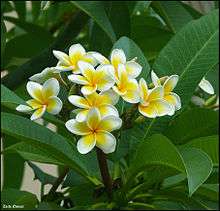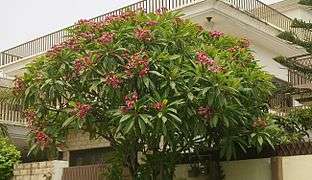Plumeria rubra
| Plumeria rubra | |
|---|---|
 | |
| Close-up on flowers of a white variant of Plumeria rubra in Israel | |
| Scientific classification | |
| Kingdom: | Plantae |
| (unranked): | Angiosperms |
| (unranked): | Eudicots |
| (unranked): | Asterids |
| Order: | Gentianales |
| Family: | Apocynaceae |
| Tribe: | Plumerieae[1] |
| Genus: | Plumeria |
| Species: | P. rubra |
| Binomial name | |
| Plumeria rubra L. | |
| Synonyms[2] | |
| |
Plumeria rubra is a deciduous plant species belonging to the genus Plumeria.[3] Originally native to Mexico, Central America, Colombia and Venezuela, it has been widely cultivated in subtropical and tropical climates worldwide and is a popular garden and park plant, as well as being used in temples and cemeteries. It grows as a spreading tree to 7–8 m (23–26 ft) high and wide, and is flushed with fragrant flowers of shades of pink, white and yellow over the summer and autumn. Its common names include frangipani,[1] red paucipan,[1] red-jasmine,[1] red frangipani, common frangipani, temple tree,[1] or simply plumeria.
Taxonomy
Plumeria rubra was one of the many species first described by the father of taxonomy Carl Linnaeus, and appeared in the 1753 edition of Species Plantarum. Its specific epithet is derived from the Latin ruber "red". The epithets acuminata, acutifolia, and lutea are seen, but these are invalid.
Common Names
In Mexico the common name is Cacaloxochitl or Suchitl. The name comes from nahuatl and means Crow's flower.[4] The common name in Australia is 'frangipani', although 'plumeria' is used in the United States. Other common names are 'red frangipani', 'common frangipani', 'temple tree', or simply 'plumeria'. The term melia is a Hawaiian one.[5] The common name 'frangipani' comes from an Italian noblefamily, a sixteenth-century marquess of which invented a plumeria-scented perfume. In the Cook Islands, it is known as Tipani. It is grown extensively in southern and western parts of India, where it is named champa or a derivative thereof such as chaaphaa, champige etc. In Cambodia it is given the names châmpéi krahâ:m (also romanised as krahom, meaning 'red'), or châmpéi slük sruëch, while the French terms for the species is frangipanier à fleurs rouges[6]
Gallery
_(4125134278).jpg) Close-up on flowers of a white variant
Close-up on flowers of a white variant Close-up on flowers of a white variant
Close-up on flowers of a white variant Plumeria tree in Israel
Plumeria tree in Israel
 White Plumeria rubra tree
White Plumeria rubra tree Pink Plumeria rubra ree
Pink Plumeria rubra ree- Red frangipani in Warje, India.
- Plumeria rubra in Tahiti
.jpg) Plumeria rubra in China
Plumeria rubra in China_on_Plumeria_rubra.jpg) Frangipani rust (caused by the fungus Coleosporium plumeriae)
Frangipani rust (caused by the fungus Coleosporium plumeriae)
Description
Plumeria rubra grows as a spreading shrub or small tree to a height of 2–8 m (5–25 ft) and similar width. It has a thick succulent trunk and sausage-like blunt branches covered with a thin grey bark. The branches are somewhat brittle and when broken, ooze a white latex that can be irritating to the skin and mucous membranes. The large green leaves can reach 30 to 50 cm (12 to 20 in) long and are arranged alternately and clustered at the end of the branches. They are deciduous, falling in the cooler months of the year. The flowers are terminal, appearing at the ends of branches over the summer. Often profuse and very prominent, they are strongly fragrant, and have five petals. The colours range from the common pink to white with shades of yellow in the centre of the flower.[3][7] Initially tubular before opening out, the flowers are 5–7.5 cm (2–3 in) in diameter, and only rarely go on to produce seed - 20-60 winged seeds are contained in a 17.5 cm (7 in) pod.[5]
Some forms in cultivation are hybrids between this species and Plumeria obtusa; these have rounded rather than pointed leaves and are less likely to be deciduous.[5] The white and yellow cultivar "Singapore" flowers all year round in Hawaii.[8]
Distribution and habitat
Its native range extends from central Mexico south through Central America to Colombia and Venezuela in South America. It is cultivated in the tropical regions of the world, and is perhaps naturalised in some parts of India[1]
Cultivation
The species is cultivated around the world in subtropical and tropical climates. In Australia, it is widely seen in cultivation in Sydney and Perth and warmer frost free climates northwards.[9] In the mainland United States, it tolerates USDA Hardiness zones 10B to 11 (southern coastal California and the southern tip of Florida).[7] It is also grown in Hawaii to an altitude of 2000 m.[5] They tolerate a wide variety of soils, from acid to alkaline and sandy to clay.[7] Widely available in nurseries, frangipanis are readily propagated by cuttings of branches taken in cooler months and left to dry for a week or more.[9] As well as gardens and street- and park planting, frangipanis are planted in temples and cemeteries.[5]
Plumeria rubra is an important crop in Hawaii, with over 14 million flowers were sold to be used in leis there in 2005.[10]
No weed potential has been recorded in the United States.[7]
Coleosporium plumeriae, known as plumeria rust or frangipani rust, is a fungus which attacks young leaves of P. rubra. It causes a brownish or orange powdery coating or blistering of leaves. It has been recorded from Hawaii and the east coast of Australia.[5][11] It was first recognised by the French mycologist Narcisse Théophile Patouillard on Guadeloupe Island in the eastern Caribbean in 1902, and had reached Taiwan by 2005.[12]
Uses
In Cambodia, as with other Plumeria species, P. rubra flowers is used to necklaces as offerings to deities or as decoration for coffins. The leaves of this species are used in the care of sores and made into soothing infusions[6] Also the flowers and bark of it are used in traditional Chinese medicine(TCM) in the treatment of fever, bacillary dysentery, pertussis and so on[13]
References
- 1 2 3 4 5 6 "Plumeria rubra". Germplasm Resources Information Network. United States Department of Agriculture. Retrieved 2009-02-01.
- ↑ "The Plant List: A Working List of All Plant Species".
- 1 2 "Botanica. The Illustrated AZ of over 10000 garden plants and how to cultivate them", p. 691. Könemann, 2004. ISBN 3-8331-1253-0
- ↑ "Biblioteca". Medicinatradicionalmexicana.unam.mx. Retrieved 2013-07-12.
- 1 2 3 4 5 6 Criley, Richard A (February 1998). "Ornamentals and Flowers OF-24: Plumeria" (PDF). Cooperative Extension Service, C/T/A/H/R. Department of Horticulture, College of Tropical Agriculture & Human Resources, University of hawaii at Manoa. Retrieved 31 January 2010.
- 1 2 Dy Phon Pauline, 2000, Plants Used In Cambodia, printed by Imprimerie Olympic, Phnom Penh
- 1 2 3 4 Gilman, Edward F.; Watson, Dennis G. (October 1994). "Fact Sheet ST-491 Plumeria rubra Frangipani" (PDF). Environmental Horticulture website. Gainesville, FL: University of Florida. Retrieved 22 July 2013.
- ↑ Scott, Susan (1991). Plants and Animals of Hawaii. Bess Press. p. 65. ISBN 0-935848-93-2. Retrieved 5 February 2010.
- 1 2 Campbell, Colin (June 3, 2006). "Fact Sheet: Frangipani". Gardening Australia Website. Australian Broadcasting Corporation. Retrieved 31 January 2010.
- ↑ "Plumeria Rubra: An Old Ornamental, A New Crop". Actahort.org. Retrieved 2013-07-12.
- ↑ Burke, Don (2001). "Weeds and Garden Pests: Frangipani Rust". Burke's Backyard website. Sydney, Australia: CTC Productions. Retrieved 4 February 2010.
- ↑ S J Roberts. "The first report of Plumeria (Frangipani) rust disease caused by Coleosporium plumeriae in Taiwan". Bspp.org.uk. Retrieved 2013-07-12.
- ↑ Plumeria rubra. "Plumeria rubra". Flower View.
| Wikimedia Commons has media related to Plumeria rubra. |